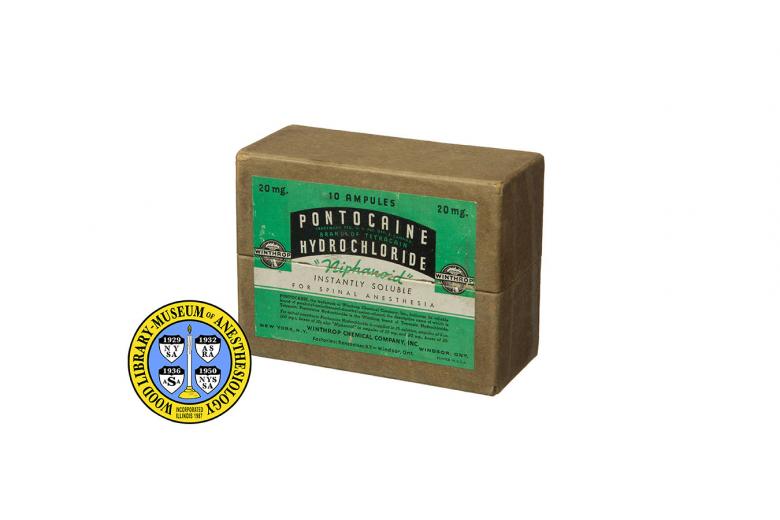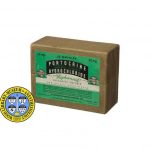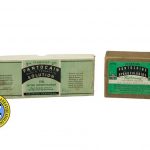Pontocaine
Pontocaine is the brand name used in the United States for the local anesthetic tetracaine. Tetracaine was first synthesized in Germany in 1928 by Otto Eisleb (1887-1948), a chemist working for IG Farben. Eisleb would later create the first synthetic opioid, meperidine (Demerol), in 1939. Among the first physicians to use tetracaine in the clinical setting was Dr. Helmut Schmidt (1895-1979), an early champion for the improvement of anesthesia care and the professionalization of anesthetists in Germany. In the United States, Dr. John S. Lundy (1894-1973) was one of the first physicians to use tetracaine in the clinical setting. His findings were published in 1931. Unlike many of the early local anesthetics that fell by the wayside, tetracaine continues to be used today. It is quick-acting and commonly used as a topical anesthetic.
Tetracaine first became available to the American market through the drug manufacturer Winthrop Chemical Company, in Rensselaer, NY (the manufacturer of the box of tetracaine pictured here). In 1923 Winthrop’s parent company, Sterling Products, began a complex relationship with IG Farben, and the subsidiary Bayer, that allowed the German company access to the U.S. market through Winthrop. The term “Niphanoid” printed on this box refers to the form in which the tetracaine was supplied: a fine, quickly dissolving powder.
Catalog Record: Pontocaine
Access Key: akgy
Accession No.: 2012-12-17-2
Title: Pontocaine hydrochloride : brand of tetracain / Winthrop Chemical Company, Inc.
Author: Eisleb, Otto (1887-1948).
Corporate Author: Winthrop Chemical Company, Inc.
Title variation: Alt Title
Title: Tetracain.
Title variation: Alt Title
Title: Tetracaine.
Title variation: Alt Title
Title: Pantocaine.
Title variation: Alt Title
Title: Pantocain.
Title variation: Alt Title
Title: Amethocaine.
Title variation: Alt Title
Title: Dicaine.
Title variation: Alt Title
Title: Pantokain.
Publisher: Rensselaer, NY: Winthrop Chemical Company, Inc., [1938-1946].
Physical Descript: 1 box ; cardboard, paper : 7 x 9.5 x 4.5 cm.
Subject: Anesthetics, Local.
Subject: Tetracaine.
Subject: Drug Packaging.
Note Type: General
Notes: Years in the range of the possible year of manufacture are based on the
earliest year of publication in which the term “Niphanoid” was used, and the
year the Winthrop Chemical Company was incorporated in to Winthrop-Stearns
Inc., and thereafter referred to as Winthrop Laboratories.
Note Type: With
Notes: The box is a container for nine clear glass ampules of 20 mg powdered
tetracaine; Each ampule varies a little in size; For example the tallest
measures approximately 5.3 cm in height and the shortest 4.9 cm; All of the
ampules are approximately 1.6 cm in diameter; Each ampule is marked with
green print; The marking includes, “20 Mg. [new line] PONTOCAINE [new line]
HYDROCHLORIDE [new line] WINTHROP”; Also contained in the box is a piece of
metal to be used to score the ampules before breaking open; The metal scorer
measures approximately 7 cm in length and 7 mm in width; It is slightly short
and serrated along one edge; A thin rectangular piece of cotton covers the
top of the ampules.
Note Type: Citation
Notes: Ball C, Westhorpe R. Local anaesthetics–nupercaine and amethocaine. Anaesth
Intensive Care. 2004;32(4):457.
Note Type: Citation
Notes: Bonica JJ. Regional anesthesia with tetracaine. Anesthesiology.
1950;11(5):606-622.
Note Type: Citation
Notes: Bonica JJ. Use of pontocaine for regional anesthesia; an analysis of 3000
cases. Curr Res Anesth Analg. 1951;30(1):1-15.
Note Type: Citation
Notes: Eisleb O, inventor; Winthrop Chemical Company, Inc., assignee.
Beta-dimethylaminoethyl ester of para-butylamino-benzoic acid. US patent 1,
889,645. November 29, 1932.
Note Type: Citation
Notes: Glaser-Schmidt E. Foreign trade strategies of I.G. Farben after World War I.
Bus Econ Hist. 1994;23(1):201-211.
Note Type: Citation
Notes: Goerig M, Schulte am Esch J. Helmut Schmidt – an early protagonist of
professionalized anaesthesia in Hamburg. In: The History of Anaesthesia: The
Fourth International Symposium on the History of Anaesthesia. Lu¨beck:
Dra¨ger; 1998:367-378.
Note Type: Citation
Notes: Lundy JS, Essex HE. Experiments with anesthetics. III. A new local anesthetic
Pantocain, for prolonged anesthesia: laboratory and clinical observations.
Proc Staff Meet Mayo Clin, or Mayo Clin Proc. 1931;6:376.
Note Type: Citation
Notes: Marvin FW. Pantocain in spinal anesthesia. N Engl J Med. August 25,
1932;207(8):368-370.
Note Type: Citation
Notes: Muschaweck R. More that 100 years development of analgesics and general and
local anaesthetics at Hoechst: a historical review. In: Schulte am Esch J,
Goerig M, eds. The History of Anaesthesia: The Fourth International Symposium
on the History of Anaesthesia. Lu¨beck: Dra¨ger; 1998:617-630.
Note Type: Citation
Notes: Wilmer WH, Paton RT. Pantocain as a local anesthetic in ophthalmology. Trans
Am Ophthalmol Soc. 1932;30:31–37.
Note Type: Citation
Notes: Wilkins M. The History of Foreign Investment in the United States, 1914-1945.
Cambridge, Mass : Harvard University Press; 2004:238, 251.
Note Type: Physical Description
Notes: One cardboard box (container) with a telescoping lid and a paper label on the
front; The label is green and white with black, green and white markings;
Beginning at the top of the label, the markings include, “20 mg.”, “10
AMPULES”, “20 MG.”, [new line] “PONTOCAINE [new line] TRADEMARK REG. U. S.
PAT. OFF. & CANADA [new line] BRAND OF TETRACAIN [new line] HYDROCHLORIDE
[new line] “Niphanoid” [new line] INSTANTLY SOLUBLE [new line] FOR SPINAL
ANESTHESIA”, [new line] “PONTOCAINE, the trademark of Winthrop Chemical
Company, Inc., Indicates its reliable brand of
parabutyl-aminobenzoyl-dimethyl-amino-ethanol, the descriptive name of which
is Tetracain. Pontocaine Hydrochloride is the Winthrop brand of Tetracain
Hydrochloride.” [new line] “For spinal anesthesia Pontocaine Hydrochloride is
supplied in 1% solution, ampules of 2 cc. (20 mg.), boxes of 10; also
“Niphanoid” in ampules of 10 mg. and 20 mg., boxes of 10.” [new line]
“WINTHROP CHEMICAL COMPANY, INC.”, [new line] “NEW YORK, N.Y.”, WINDSOR, ONT.
” [new line] Factories: Rensselaer, N.Y. – Windsor, Ont.”, “PRINTED IN U.S.A.
“; Inside of the box there are cardboard dividers that create ten rectangular
spaces to separate and secure the ampules held within.
Note Type: Reproduction
Notes: Photographed by Mr. Steve Donisch on January 14, 2013.
Note Type: Historical
Notes: Pontocaine is the brand name used in the United States for the local
anesthetic tetracaine. In other countries it may also be referred to as
Pantokain, Amethocaine, Dicaine, or Ametop. Tetracaine was first synthesized
in Germany in 1928 by Otto Eisleb (1887-1948), a chemist working for IG
Farben. Otto Eisleb would later create the first synthetic opioid, meperidine
(Demerol), in 1939. A number of physicians were employed to test tetracaine
in the clinical setting, including Dr. Helmut Schmidt (1895-1979), an early
champion for the improvement of anesthesia care and the professionalization
of anesthetists in Germany. In the United States among the first to use
tetracaine in the clinical setting was Dr. John S. Lundy (1894-1973). His
findings were published in a 1931 issue of the Proceedings of the Staff
Meetings of the Mayo Clinic. Unlike many of the early local anesthetics that
fell to the wayside, tetracaine continues to be used today. It is quick
acting and commonly used as a topical anesthetic.
Note Type: Historical
Notes: Tetracaine first became available to the American market through the drug
manufacturer Winthrop Chemical Company, in Rensselaer, NY (the manufacturer
of the box of tetracaine described here). In 1923 Winthrop’s parent company,
Sterling Products, began a complex relationship with IG Farben, and the
subsidiary Bayer, that allowed the German company access to the U.S. market
through Winthrop. The term “Niphanoid” printed on this box refers to the form
in which the tetracaine was supplied: a fine, quickly dissolving powder.
Note Type: Publication
Notes: Fussganger R, Schumann O. Uber ein neues Lokalanasthetikum der Novokainreihe
(Pantokain). Archiv für experimentelle Pathologie und Pharmakologie. April 25
1931;160:53-65.
Note Type: Exhibition
Notes: Chosen for the WLM website (noted February 26, 2013).



